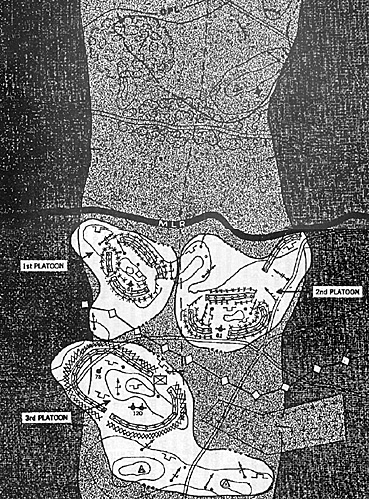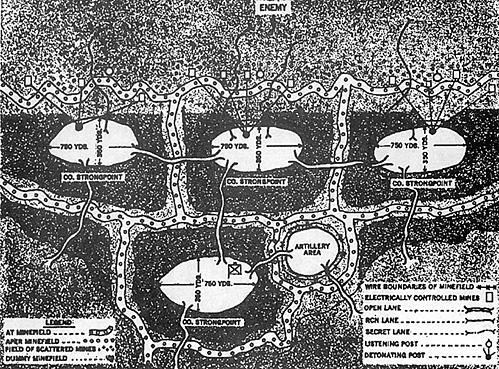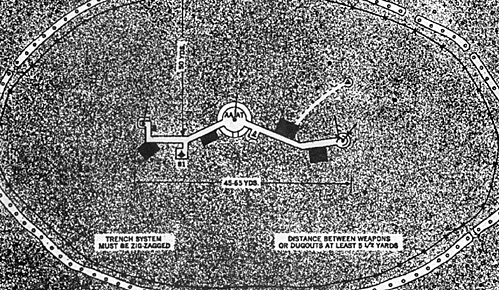 A: GENERAL
A: GENERAL
The Germans attempt to break a hostile attack in front of the main line of resistance (Hauptkampfinie), at the forward limit of the battle position (Hauptkampffeld), or to force the enemy to abandon his attack.
As in US practice, the commander usually determines from the map the main battlefield and assigns a general line as guide for the location of the main line of resistance to ensure continuity of the defensive position. Lower echelon commanders fix the main line of resistance on the ground, since only on the terrain after thorough reconnaissance, can the details of the defense be decided. A recent official German directive states, however, that reconnaissance must not delay the construction of defensive positions.
Organization of the defensive position follows a conventional pattern and includes an advanced position (Vorgeschobene Stellung) and an outpost position (Gefechtsvorposten), both of which usually are under immediate command of the area commander. A reserve position may also be provided.
The width and depth of a German defense area depend upon the terrain and the proportional strength of friendly and hostile forces. In general, however, the width of a defensive sector assigned to a unit is approximately twice the width of the sector when the same unit attacks. Normal sectors are: platoon, 220 to 550 yards; company, 440 to 1,100 yards; battalion, 880 to 2,200 yards; regiment, 2,200 to 3,300 yards; division, 6,600 to 11,000 yards.
B. ADVANCED POSITION
The Germans organize the advanced position 5,000 to 7,000 yards in front of the main line of resistance, within the range of their medium artillery. A position is selected which will prevent seizure by the enemy of important terrain features, provide good observation points for friendly artillery, and, if possible, deceive the enemy as to the location of the main line of resistance. Troops manning these positions attempt to make the enemy deploy his forces prematurely and, if possible, in the wrong direction.
The forces in the advanced position are usually reconnaissance detachments which include machinegun, armored-car, and antitankgun units, the fire power and mobility of which make them suitable for this type of employment. In general, they occupy important features such as railroads, river crossings, cross-roads, and commanding ground. Forces in advanced positions are not expected to hold at all cost; in the face of superior enemy fire, they retire along predetermined routes under cover of their medium artillery.
C. OUTPOST POSITIONS
Outpost positions normally are established 2,000 to 5,000 yards in front of the main line of resistance. When the fronts are stabilized, the outpost position is the only position forward of the main line of resistance. The location, which depends upon the terrain, is always within range of friendly light artillery.
German outpost positions are occupied in strength varying from platoons to companies, depending upon the mission, terrain, width of the sector, and the number of troops available. Often they are only weakly occupied as long as the advanced positions are in front of them. Ordinairily, outposts are established by infantry units drawn from the main battle position, and supported by the fire of closes-upport weapons, such as mortars and infantry guns. Antitank guns often are attached to these outpost units to repel hostile armored reconnaissance units. The main weapon, however, is the light machinegun, which opens fire at ranges of about 1,300 yards, while riflemen commence fire at about 850 yards.
Firing positions are selected by the Germans to facilitate unobserved withdrawal of the outposts to the main battle position when hostile pressure becomes too strong. Several alternate positions are prepared for each weapon, and shifts are made by day and night to make it difficult for the opponent to detect and dislodge the outpost troops. Positions normally are selected at the edges of woods, villages, hedgerows, or hills.
A good field of fire is considered mandatory, and the organization of firing positions is simple. Numerous dummy positions are constructed, including knee-deep trenches filled with leaves to simulate depth and occupancy. During the day, positions are manned by guards; at night, advanced listening posts, particularly alert at dusk and dawn, warn the troops of the enemy's approach. Small, prepared attacks with limited objectives under the protection of the outposts are utilized to interfere with the hostile preparations and secure information.
Withdrawa1 of the outposts is conducted so as not to hinder the fire of the main battle position. After the outposts are abandoned, they are likely to be covered by carefully registered fire of heavy weapons in order to prevent their occupation by the enemy.
 D. MAIN LINE OF RESISTANCE
D. MAIN LINE OF RESISTANCE
The Germans organize their battle position in-depth, with individual strongpoints connected to form an uninterrupted belt. The strongpoints, constructed for all-around defense and surrounded by barbed-wire obstacles and mine belts, contain one or more heavy weapons supplemented by machine guns, mortars, and riflemen. The smallest strongpoint is occupied by a reinforced squad. Squad strongpoints normally are incorporated into platoon strongpoints, and the latter into company strongpoints, etc.
Jumbo Battalion Position (by Company) Extremely slow: 374K
The Germans make the maximum use of reverse slopes in their defensive positions. Forward-slope positions are usually avoided as they are detected too early by the enemy and are likely to be destroyed by massed fire. Since organization of a position in woods requires much time and labor, and strong occupation is requisite to compensate for poor observation, the Germans also avoid woods when time is short and labor scarce. Battle positions are laid out so that woods are neither in, nor directly in front or in rear of, defense installations. The Germans believe, however, that when it is possible to establish a well-prepared position in a woods, a position so located offers the same advantages as a reverse slope.
When the Germans decide to construct defensive positions on terrain divided by a stream, they organize bridgeheads on the bank on the hostile side where the terrain facilitates crossings. Where the river forms a re-entrant bend into enemy-held terrain, a second position is constructed at the base of the bend. On narrow rivers and creeks, the entire German main line of resistance is on the hostile side of the river, and the stream becomes the tank obstacle of the position. (See anti-mechanized defense.) When the friendly side of the river consists of swampland, it is used as an obstacle and the hostile bank is not included in the defense system.
The Germans endeavor to provide all parts of their position with strong support from artillery and heavy infantry weapons. A detailed fire plan is prepared in advance by the infantry and coordinated with the artillery plan. Provision is made for fire in front of the forward limit of the battle position, which is partly protected by mineftelds, and other obstacles. Alternate positions are dug so that support weapons may be shifted and fired rapidly. The mass of the artillery lays concentrated fire both close to and well in front of the main line of resistance, and is sited to cover the spaces between the effective fire zones of front-line units.
The Germans in general adhere to the principle of "effect before cover' in determining priorities for constructing the various installations in a defense position. First, they build combat trenches; erect infantry obstacles such as barbed-wire fences; and construct machine-gun positions, dugouts, foxholes, and antitank positions. They clear fields of fire by careful cutting of underbrush, but try to avoid cutting down trees in order to preserve concealment of the position. The underbrush is left in front of the position as far as one to three yards. They organize observation posts for artillery and heavy infantry weapons, increase the depth of the battle position, dig communication trenches and emplacements for the heavy infantry weapons, and build command posts. Finally, they construct emplacements for the artillery, dig antitank ditches within the battle position, and build dummy positions.
 The Germans insist on thorough camouflage. Whenever practicable,
trenches and wire obstacles are placed along natural terrain lines such as
rows of brush or edges of fields. Trenches are dug zigzag at obtuse angles,
330 to 660 yards long, depending on the terrain.
The Germans insist on thorough camouflage. Whenever practicable,
trenches and wire obstacles are placed along natural terrain lines such as
rows of brush or edges of fields. Trenches are dug zigzag at obtuse angles,
330 to 660 yards long, depending on the terrain.
MGs are emplaced in trenches 1-3 yards in length. To avoid silouettes, the Germans heap more earth behind the trenches. Dugouts for riflemen and for MG positions normally provide sufficient protection against enemy artillery and mortar fire. Whenever possible, three layers of logs and earth are used as cover.
E. RESERVE POSITION
Occasionally, a reserve position is organized and troops in the main line retire to it, but only under heavy pressure. This reserve position is constructed far enough to the rear to compel hostile artillery to displace forward in order to bring it under fire. Motorized reserve units normally are kept there for counterattacks which are planned in advance.
F. ANTI-MECECHANZED DEFENSE
In constructing a defensive position, the Germans stress construction of obstacles and antitank defenses. If possible, they select tank-proof terrain, and natural tank obstacles, such as steep slopes, am improved. Very steep forward slopes are made at least eight yards deep, while uphill slopes are made two to three yards high.
Originally, the Germans constructed antitank ditches well forward of the main line of resistance, but experience taught them that such ditches offered favorable jumping-off positions for hostile infantry and also revealed the location of the main line of resistance. At the present time, therefore, antitank ditches normally are dug in the area between the main line of resistance and the artillery positions. They are built in an unintertupted line to avoid leaving passages that can be exploited by the enemy.
All crossings essential to assure the maneuverability of friendly troops are built so that they can be blown up on the shortest notice.
The Germans are aware that obstacles of any kind are effective only when covered by fire from various weapons. Consequently, there usually are trenches behind the antitank ditches from which machine-gun and antitank- gun fire can cover the entire length of the tank obstacle.
The Germans learned that dense minefields in front of their positions were an inadequate tank obstacle because the enemy usually neutralized them by massed artillery fire or by concentrated air bombardment before launching a large-scale attack. Now German minefields normally are laid within the main battle position, and only single mines are dispersed in patterns at wide intervals in front of the main line of resistance. Particular stress is placed on the mining of roads. Routes of withdrawal which have to be left open are prepared for mining, and, if time does not permit placing of actual mines, dummy mines are installed.
The Germans employ many kinds of tank obstacles. They recently have used static flame throwers dug into the ground. Usually sited in pairs and in conjunction with other tank obstacles, they are fired by well concealed personnel as soon as hostile tanks come within range.
German antitank guns are disposed in depth, with some well forward. They often are dug in and carefully concealed to prevent the enemy from discovering the location and strength of the antitank defenses prior to attack. In emplacing antitank guns, the Germans prefer positions in enfilade or on reverse slopes. They normally employ two to three antitank guns in each position, protecting them from infantry attacks with light machine guns.
Ranges at which the Germans open fire upon hostile tanks vary according to the caliber of the gun and its position. Although single antitank guns sometimes engage enemy tanks at ranges up to 1,000 yards, main antitank defenses usually hold their fire until the range is reduced to about 150 to 300 yards. The employment of close-combat antitank teams supplements the antitank defense. When the hostile tank attack is repulsed, the antitank guns move to alternate positions.
The Germans emphasize that the use of smoke can be of great assistance in defeating enemy tank attacks. Smoke shells are fired into the attacking formation at about one-third of the distance back from the leading echelon. Thus the Germans avoid blinding their own antitank gunners, and leading hostile tanks not only are left without adequate support, but are silhouetted against the smoke. The Germans also rely on the smoke being sucked into the tanks and forcing the crews to dismount.
Verteidigung WWII German Defensive Doctrine
-
1. Introduction and General
2. Organization for Defense
3. Conduct of the Defense
4. Defense of Towns
5. Doctrine of the Westwall System
Back to Table of Contents -- Combat Simulation Vol 1 No. 4
Back to Combat Simulation List of Issues
Back to MagWeb Magazine List
© Copyright 1995 by Mike Vogell and Phoenix Military Simulations.
This article appears in MagWeb (Magazine Web) on the Internet World Wide Web.
Other military history articles and gaming articles are available at http://www.magweb.com